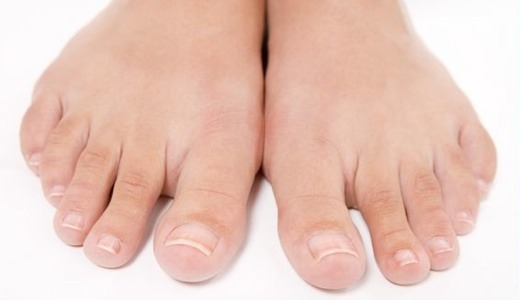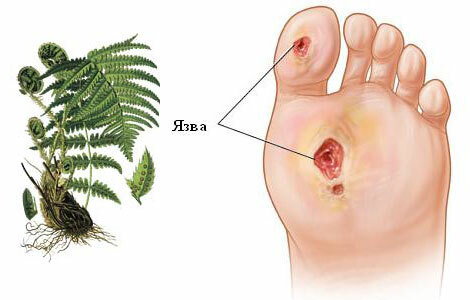Everyone knows that diabetics in the blood have a high level of sugar, which affects small vessels. After a while they are destroyed, thereby worsening the movement of blood in the legs. Thus, non-healing wounds appear, if left untreated, gangrene is formed, leading to amputation of the lower extremities.
Often, patients experience a complication - diabetic neuropathy. With this deviation, nerve endings are destroyed, and the skin on the legs becomes vulnerable. Burning, scratching, corn - it all leads to serious problems, the healing of which takes much longer than in healthy people. A person with diabetes needs to know the basic things that will lead to severe treatment and disability.
Dryness of the skin

If there is an excess of sugar in the blood, the diabetic begins excess urination, there is a loss of fluid in the body. The skin begins to dehydrate, which eventually becomes dry and flaky. Also, the work of sweat and sebaceous glands is disrupted. Then there is burning, cracks, leading to infections. Walking with cracks the patient becomes uncomfortable, especially on the heels.
So that the skin is not affected, one should adhere to the basic rules of hygiene. The patient does not use ordinary toilet soap, it lowers the acidity of the surface tissue, which leads to damage by microbes. Lower limbs and hands are best washed with pH-neutral soap. You should carefully monitor your legs. The skin should always be clean. In daily care of her, you need to apply emollients and moisturizers. The most effective substance is the agent with urea.
Corns
Diabetics can easily develop ulcers with excessive corns( hyperkeratosis).They are not so hard to earn, it is only necessary to wear tight shoes, as there are burrs and calluses. The arising defects press on an integument under which there is a hemorrhage, as a result the ulcer is formed.
Patients with diabetes should wear comfortable and soft shoes, so as not to cause corns and corns. With the formed corn, it is forbidden to cut it and steam it out in hot water, and also apply a patch. It is best to use a softening ointment with a urea content 3 times a day. The agent should be applied to a clean surface.
Fungus
With a weakened immune system, diabetics actively multiply fungus if a mycosis pathogen enters. In healthy people, such an infection is much less common than those who have diabetes. When mycosis falls on the nail plate, its color begins to change, the nails become thick and puff. At the time of wearing shoes, because of thickening of the plate, trophic ulcers may appear due to additional pressure on the finger. To prevent complications, the patient should regularly reduce the stratum of the affected nail. The nail plate must be treated with a pumice stone or saw blade.

In diabetics, thermoregulation is impaired, resulting in increased sweating and diaper rash in the skin folds. To prevent fungal infections, it is necessary to treat places of excessive sweating with creams with zinc oxide or talc. Irritation and itching indicate the presence of an infectious fungus. For today in drugstores it is possible to get a wide spectrum of ointments and creams which will help to cope with an infection.
Cuts
Even minor wounds, small cuts, injections can lead to infection of the skin. At the time of the defeat of the skin, it is necessary to treat the wound with an antibacterial agent( furacilin, hydrogen peroxide or a special agent).Do not use medicines containing alcohol. If the patient after the cut has an inflammation with pain, you need to contact your doctor. Self-selected ointment can only worsen the clinical picture.
Diabetic ulcer
Trophic ulcers are infected wounds that have not been cured in time. If an ulcer occurs, the patient undergoes a course of therapy in the diabetic foot. Treatment consists in the treatment of wounds with antibacterial drugs without alcohol, as well as in the use of antibiotics and modern materials for dressings.
Purulent-defensive leg lesion
In diabetics, the most serious lesion is SDS( diabetic foot syndrome), which can lead to amputation of the lower extremity. When a patient suffers from nerve endings, a person does not feel pain. He can get burned, step on something sharp, rub his foot, but he will not feel it.
The manifestation of the diabetic foot syndrome is characterized by:
- phlegmon soles,
- infectious inflammation of the foot bones,
- gangrene( can be localized on one finger or on the entire foot),
- trophic ulcer,
- long-term non-healing wound.

Many patients turn to specialists with a severe complication stage, when they have to amputate the limb. For treatment to be without significant costs and in a short time, you need to carefully look after your legs, and also follow the prevention. The patient is prescribed treatment in the diabetic foot. The specialist prescribes a suitable ointment or cream, makes dressings.
Traditional medicine
In addition to drug therapy, treatment of wounds is effective with the help of folk remedies:
- With purulent wounds helps the cucumber juice. It has antimicrobial properties. With the help of juice, lubricate a sore spot or make a compress, then you should treat the affected area with drugs prescribed by the doctor.
- To the ulcer or wound, you can apply the leaves of celandine, then bandage your foot.
- For badly healing wounds make a decoction of the roots of celandine and burdock. To do this, you need to grind 30 g of burdock, 20 g of celandine, add 100 ml of sunflower oil. It is necessary to boil the mixture on a low heat for 15 minutes, strain it. It should be lubricated wounds 3 times a day for a week.
Prevention
To avoid the occurrence of long-term non-healing wounds, ulcers, and even worse amputation, basic precautions should be followed:
- It is recommended that the feet be inspected daily for damage.
- Wear comfortable and soft shoes.
- In cold weather, your feet should be warm.
- Do not use products that dry the skin.
- Do not walk barefoot.
- Quit smoking. Cigarettes worsen blood circulation.
- Do not remove corns or calluses yourself.
- Do not take a long bath or shower.
- Treat antiseptic means even a minor wound.
If the wound is not treated in time, the infection gets into it, the healing of the affected areas is much more difficult to treat. A person with diabetes mellitus needs careful care for the wounded skin.



